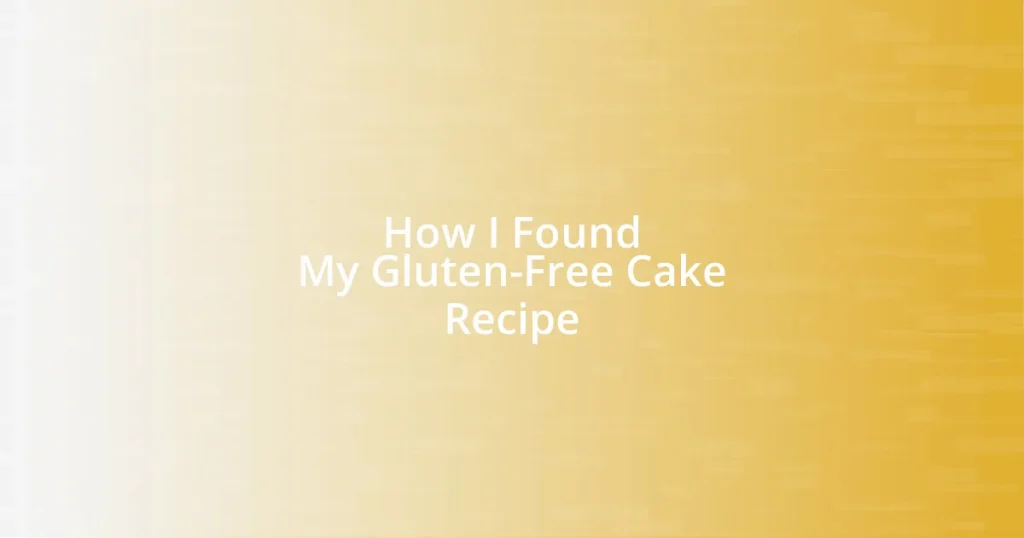Key takeaways:
- The author’s initial experience with gluten-free baking was filled with uncertainty but turned into a journey of joy and creativity.
- Understanding gluten’s effects highlighted the importance of creating gluten-free meals to accommodate health concerns, expanding the author’s knowledge of alternative flours.
- Joining gluten-free baking communities provided vital support and resources, enriching the author’s baking journey and boosting confidence.
- Experimentation with different gluten-free flours and ingredients led to significant breakthroughs, transforming baking into a blend of science and creativity.
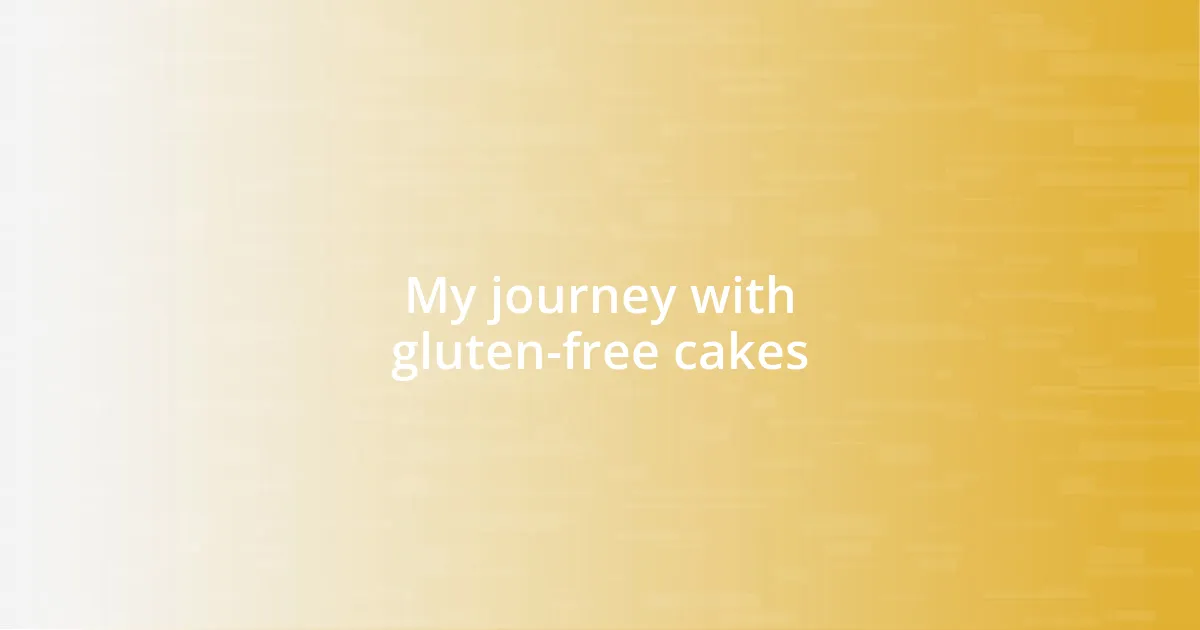
My journey with gluten-free cakes
My journey with gluten-free cakes began unexpectedly. I remember the first time I baked one; the kitchen was filled with a blend of uncertainty and hope. I can still hear my son’s voice, “Is it going to be edible, Mom?” That question lingered as I stirred the batter, a mix of new flours that felt so foreign to me.
As I tasted that first slice, a wave of relief washed over me. It wasn’t just about making a cake that was gluten-free; it was about crafting something that brought joy to my family without the fear of discomfort. Have you ever tried to create something special only to face that moment of doubt? I found that moment to be a turning point; it propelled me to embrace the challenge with passion rather than hesitation.
Looking back, I cherish the journey of experimentation and discovery. Each recipe attempt was like a little adventure, often accompanied by laughter and the anguish of mishaps. Remember the cake that collapsed? With each failure, I not only learned about gluten-free ingredients but also about resilience and creativity in the kitchen. Who knew that a simple cake could teach me so much about myself?
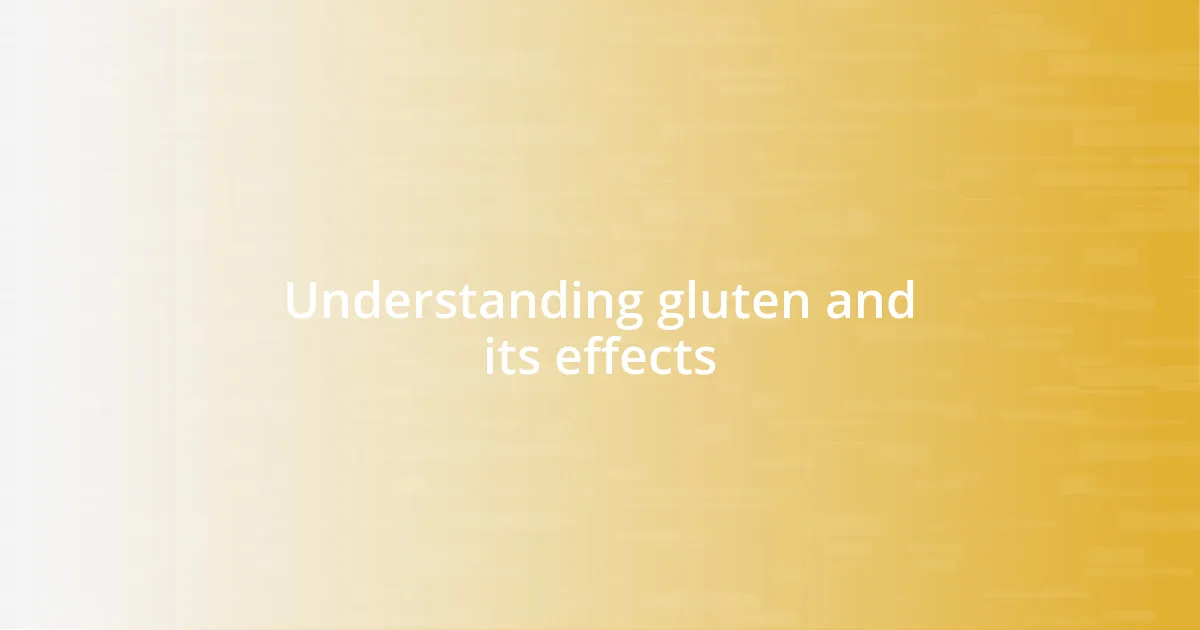
Understanding gluten and its effects
Understanding gluten can feel a bit overwhelming, especially if you’re just starting to explore gluten-free options. Gluten is a protein found in wheat, barley, and rye, and it gives dough its elasticity and allows bread to rise. When I first learned about gluten’s role in baking, it struck me how central it is to traditional recipes. I realized that removing it isn’t just about substituting ingredients; it’s a complete rethinking of how we approach baking itself.
For many people, gluten can trigger adverse reactions, ranging from mild sensitivity to severe conditions like celiac disease, where the immune system reacts to gluten and damages the small intestine. This was a revelation for me as I had a friend struggle with these issues, often feeling unwell after meals. Witnessing her discomfort opened my eyes to the importance of crafting meals that are enjoyable without the fear of repercussions. Have you ever considered how food can significantly impact both physical health and social experiences?
As I delved deeper into gluten and its effects, I realized the importance of understanding alternative flours. They don’t just vary in flavor and texture, but also in nutritional value, which can shift the entire baking experience. For instance, almond flour gave my cakes a delightful nuttiness but required extra moisture. Each flour brings its own personality to the table. Isn’t it fascinating how changing one ingredient can lead to such different outcomes in our favorite dishes?
| Gluten | Effects |
|---|---|
| What is it? | A protein found in wheat, barley, and rye. |
| Common effects on individuals | For some, it causes mild digestive discomfort; for others, it can lead to severe health issues like celiac disease. |

Finding trusted gluten-free resources
Finding reliable gluten-free resources was one of the most crucial steps in my baking journey. I learned early on that not all gluten-free ingredients are created equal. I fondly recall stumbling upon a local gluten-free baking group online; it felt like a gold mine. The sharing of tips, recipes, and experiences from fellow bakers encouraged me tremendously. It was comforting to know I wasn’t alone in my quest to create delicious gluten-free cakes that everyone could enjoy.
When searching for trustworthy information, I always aim for resources that are both reputable and relatable. Here are some of my go-to places for gluten-free baking guidance:
- Cookbooks by trusted authors: Look for those who specialize in gluten-free baking. They often share insights that go beyond just the recipes.
- Established gluten-free blogs: Bloggers who live gluten-free lifestyles tend to provide authentic recipes along with personal tips and tricks.
- Social media support groups: Joining communities on platforms like Facebook can offer real-time advice and camaraderie.
- YouTube tutorials: Watching someone else bake gluten-free can clarify techniques that are tricky to grasp through text alone.
- Local health food stores and bakeries: Don’t underestimate the power of face-to-face conversations; engaging with knowledgeable staff can lead you to hidden gems.
I distinctly remember my first encounter with a gluten-free flour blend that I found at a local bakery. I nervously asked the baker how she achieved that perfect crumb, and her response felt like a revelation. Connecting with others who shared my passion made all the difference. Their experiences enriched my understanding and equipped me with the confidence I needed to experiment further.
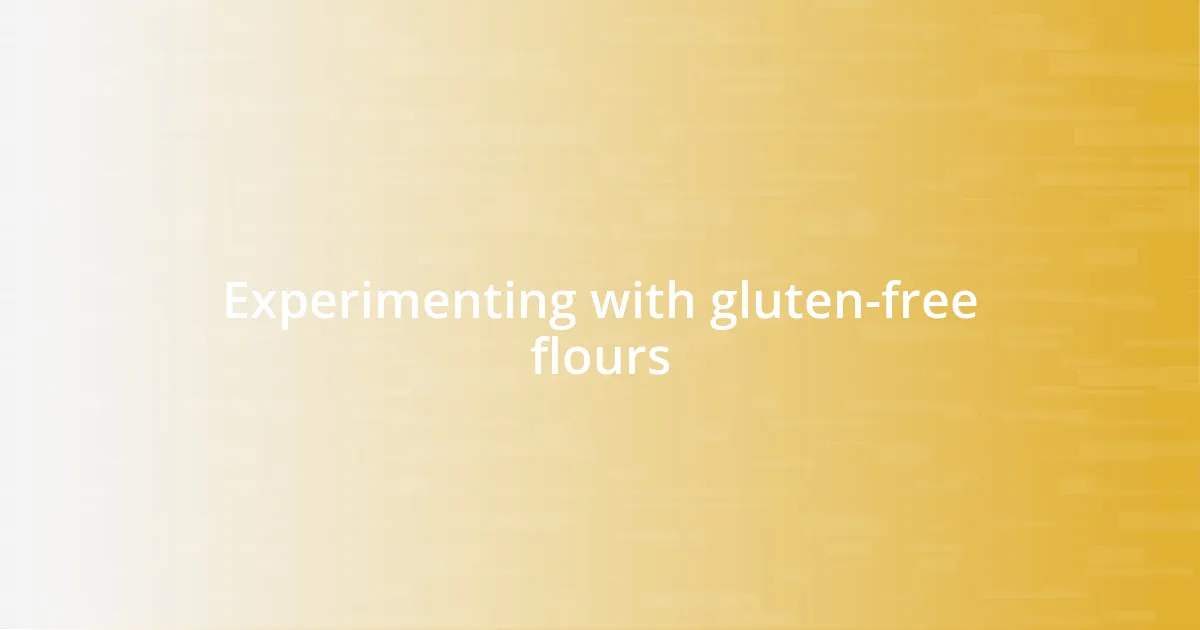
Experimenting with gluten-free flours
Experimenting with gluten-free flours was a true adventure for me. I recall the first time I tried coconut flour; it felt like walking a tightrope. The fine texture absorbed liquid like a sponge, and my cake turned out more like a brick than a fluffy dessert. Have you ever faced a baking disaster? It’s those moments that push you to learn and adapt.
As I navigated through various gluten-free flours, I found a blend of brown rice and tapioca flour that completely changed the game for my cakes. The lightness and chewiness it gave were a revelation. It made me wonder—how does one ingredient alter the entire experience? It felt like unlocking a door to a new world of baking, where I could blend creativity with food science.
I realized that with each flour, I had to adjust not just the ratios but also the liquids and binding agents. For instance, using a mix of oat and almond flour introduced a delightful nuttiness while requiring less sweetener. This experimentation transformed my baking into a science project, where every attempt was a unique lesson. Who knew gluten-free baking could be so thrilling? Each failure felt like a stepping stone, leading me closer to my ideal cake.

Testing various cake recipes
Testing various cake recipes opened up a world of discoveries for me. I began with a classic vanilla cake, subbing in gluten-free ingredients, and the results were both surprising and frustrating. I distinctly remember anxiously pulling out the first cake from the oven, only to find it was a gooey mess! Have you ever had that sinking feeling when you realize your hard work hasn’t paid off? That moment taught me to embrace imperfection and fueled my determination to find the right combinations.
As I continued testing, each recipe became a lesson in flavor and texture. One memorable experiment involved adding a hint of citrus to a chocolate cake. The zing really brightened the flavor, flipping my expectations on their head. It was amazing to think that a simple tweak could elevate a recipe so dramatically. How often do we overlook the little things that make a big difference? That realization sparked my creativity—what else could I experiment with?
Through countless trials, I developed a keen sense of what ingredients worked well together. A batch of carrot cake with added spices created a warm, inviting flavor profile that reminded me of cozy family gatherings. I felt that rush of nostalgia, reminding me why I love baking in the first place—it’s about sharing joy with others. Each recipe tested brought me a step closer to my dream gluten-free cake, and it fueled my passion as I envisioned what the perfect slice might look like.
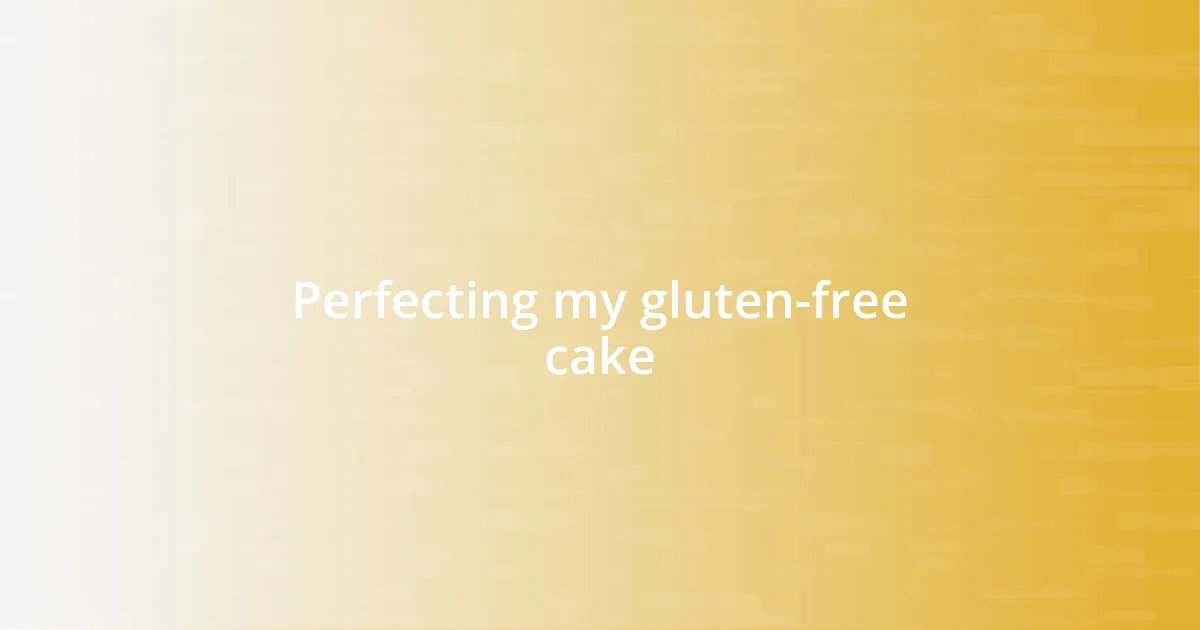
Perfecting my gluten-free cake
Perfecting my gluten-free cake was a journey filled with trial, error, and plenty of sweet moments. I vividly remember one particularly rainy afternoon when I decided to make a chocolate hazelnut cake. As I pulled it from the oven, the aroma filled my kitchen, wrapping me in warmth. But when I sliced into it, my heart sank; the texture was too dense. Have you ever poured your heart into something only to find it lacking? That day, I learned that the right balance of moisture is key in gluten-free baking, and I was determined to keep refining my approach.
After several attempts, I stumbled upon the magic of adding applesauce to my batter. Not only did it create a lovely moisture, but it also elevated the cake’s flavor profile. The first time I baked with it and tasted the cake, I felt a wave of euphoria; it was a light and fluffy triumph. Have you ever felt that exhilarating rush when a baking experiment pays off? It’s a feeling like no other, making all the earlier mishaps seem worth it. This experience solidified my belief that every recipe needed personalization, turning what could be mundane into something truly special.
I found that incorporating spices such as cinnamon and a hint of nutmeg breathed new life into my cakes, enhancing their warmth and familiarity. I often caught myself daydreaming about hosting a cozy gathering with friends, serving them slices of this lovingly crafted creation. That anticipation drove me to experiment even more. Isn’t it incredible how food can spark joy and connection? Each perfected recipe felt like a personal victory, strengthening my resolve to make gluten-free baking a delightful experience for everyone I shared it with.










